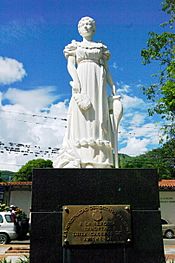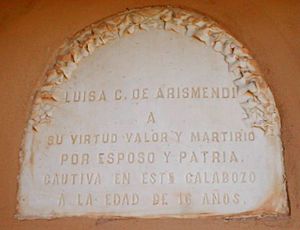Luisa Cáceres de Arismendi facts for kids
Quick facts for kids
Luisa Cáceres Díaz de Arismendi
|
|
|---|---|

A posthumous portrait of Luisa Cáceres de Arismendi by Emilio Jacinto Mauri
|
|
| Born | September 25, 1799 |
| Died | June 28, 1866 (aged 66) |
| Spouse(s) | Juan Bautista Arismendi |
María Luisa Cáceres Díaz de Arismendi (born September 25, 1799 – died June 2, 1866) was a brave hero who fought for Venezuela's freedom. She played an important part in the Venezuelan War of Independence.
Contents
Luisa's Early Life and the Start of War
Luisa was born in Caracas, Venezuela. Her parents, José Domingo Cáceres and Carmen Díaz, were wealthy Criollos. Her family had roots in the Canary Islands. She was baptized in the Church of Santa Rosalía in Caracas.
Her father was a smart man, a historian, and a Latin professor. He taught Luisa to read and write, and she learned to love her country. While Luisa was young and studying, Napoleon took over Spain. He made his brother, Joseph, the new king.
People in Spain and its colonies were very angry. A war for Spain's freedom began. In Venezuela, Spanish colonists saw this as a chance to break away from Spain. They wanted to become independent.
Many uprisings happened in Venezuela. These were led by Francisco de Miranda, a Venezuelan general. He had also been part of the French Revolution and the American Revolutionary War. Venezuela declared itself free from Spain on July 5, 1811. This started Venezuela's own war for independence.
In 1812, a big earthquake hit Caracas, where Luisa and her family lived. The city was completely destroyed. Because of the earthquake and a rebellion, the First Republic of Venezuela fell. A second Venezuelan republic was created in 1813. But it also lasted only a few months before it was defeated.
Meeting Juan Arismendi
On Christmas Eve in 1813, Luisa met General Juan Bautista Arismendi. He was impressed by how smart she was. On March 6, 1814, royalist troops attacked Ocumare. Luisa's father was killed there while visiting a friend.
Juan Bautista Arismendi led a group to Ocumare to save captured patriots. Luisa's brother, Félix, joined them. But he was caught and killed a few days later. José Tomás Boves forced the patriot soldiers to leave Caracas. This retreat was called the Migration to the East. It was led by Simón Bolívar and José Félix Ribas.
Luisa's family decided to move to Isla Margarita. Arismendi offered them safety there. During the journey, four of her aunts died. Only Luisa, her mother, and her younger brother survived. They passed through Barcelona and Cumaná, which Boves had taken over.
Marriage and Capture
In Margarita, Arismendi found the Cáceres family. He had known them for some time. He gave them clothes, a home, and other things they needed. He and Luisa got married on December 4, 1814, in La Asunción. He was 39 years old, and she was 15.
In 1815, Juan became the temporary governor of Margarita. At the same time, Pablo Morillo, a royalist general, arrived with a huge fleet. In September, the Spanish ordered Juan's arrest. He had to hide in the mountains.
On September 24, the Spanish captured Luisa, who was pregnant. They wanted to pressure her husband. She was first held under house arrest. Later, she was moved to a dark prison cell in the Fortress of Santa Rosa.
Luisa's Imprisonment
In that dark prison, Luisa was treated badly by the Spanish soldiers. She was watched closely and given very little food. She started to suffer from poor nutrition. She spent many days and nights trying not to move much, so her jailer wouldn't notice her.
However, the prison chaplain felt sorry for her. He started bringing her better food. He even lit up her cell so she could have some light. On January 26, 1816, Luisa gave birth to a daughter. Sadly, the baby died soon after birth. This was because of the terrible conditions Luisa faced during her pregnancy.
The Spanish generals, Juan Bautista Pardo and Salvador Moxó, ordered Luisa to be moved. First, she went to the Castillo San Carlos de Borromeo in Pampatar. Then she was sent to a prison in La Guaira. After that, she was moved to a convent in Caracas called El Convento de la Inmaculada Concepción. During all this time, she could not talk to her family or friends.
Leaving the Country and Return
The republican army started winning battles. Luisa's husband was winning in Margarita. General José Antonio Páez was winning in Apure. Because of these victories, Moxó ordered Luisa to be sent to Cádiz, in Spain.
She was returned to La Guaira on November 24, 1816. She then left for Spain on December 3. On the way, the ship was attacked by a privateer (a ship hired by a government to attack enemy ships). Luisa and other passengers were left stranded on Santa Maria Island in the Azores.
Luisa finally arrived in Cádiz on January 17, 1817. She was brought before the captain general of Andalusia. He disagreed with the unfair decision of the Spanish leaders in the Americas. He gave Luisa the status of being "confined," meaning she was restricted but not a prisoner. He also gave her a small payment each day.
A doctor named José María Morón and his wife, Concepción Pepet, protected her. They paid a deposit and agreed to present her to a judge every month.
Refusing to Give Up
While in Cádiz, Luisa refused to sign a paper. This paper would have said she was loyal to the king of Spain. It would also have said she was not a patriot of Venezuela. She never gave up her dream of an independent Venezuela. She still had no news about her mother or her husband.
In March 1818, Lieutenant Francisco Carabaña and an Englishman, Mr. Tottem, offered to help Luisa return to the Americas. As they planned her escape, Luisa promised that her husband would pay for everything later. Luisa said goodbye to the Morón family and left for the United States of America on a large ship called a frigate.
On May 3, 1818, Luisa arrived in Philadelphia. There, she met the family of General Lino Clemente, who had moved to the United States. They welcomed her and became her friends, just like the Morón family in Spain.
Colonel Luis Rieux, sent by Luisa's husband, came to Philadelphia to take her back to Margarita. They arrived on July 26, 1818. Later, on September 19, 1819, a Spanish council decided that Luisa was completely free to choose where she wanted to live.
She went on to have eleven children. She continued to support the idea of freedom for the people of the Americas. She lived in Caracas until she passed away in 1866.
Honors and Legacy
- In 1876, Luisa's remains were placed in the Panteón Nacional. This was to honor her loyalty and fight for Venezuela's freedom. She was the first woman to receive this great honor.
- A statue of her stands in a plaza named after her in La Asunción, where she was married.
- Today, in Caracas, there is a school called the University Institute Luisa Cáceres de Arismendi.
- Her picture is on the Venezuelan Bs.F 20 banknote. This banknote was introduced in 2008.
- A Boeing 747-300 airplane of Emtrasur Cargo was named after her.
Gallery
See also
 In Spanish: Luisa Cáceres de Arismendi para niños
In Spanish: Luisa Cáceres de Arismendi para niños









